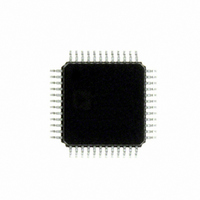ADUC7060BSTZ32 Analog Devices Inc, ADUC7060BSTZ32 Datasheet - Page 95

ADUC7060BSTZ32
Manufacturer Part Number
ADUC7060BSTZ32
Description
DUAL 24-BIT AFE AND ARM 7 I.C
Manufacturer
Analog Devices Inc
Series
MicroConverter® ADuC7xxxr
Specifications of ADUC7060BSTZ32
Design Resources
4 mA-to-20 mA Loop-Powered Temperature Monitor Using ADuC7060/1 (CN0145) Low power, Long Range, ISM Wireless Measuring Node (CN0164)
Core Processor
ARM7
Core Size
16/32-Bit
Speed
10MHz
Connectivity
I²C, SPI, UART/USART
Peripherals
POR, PWM, Temp Sensor, WDT
Number Of I /o
14
Program Memory Size
32KB (16K x 16)
Program Memory Type
FLASH
Ram Size
4K x 8
Voltage - Supply (vcc/vdd)
2.375 V ~ 2.625 V
Data Converters
A/D 5x24b, 8x24b, D/A 1x14b
Oscillator Type
Internal
Operating Temperature
-40°C ~ 125°C
Package / Case
48-LQFP
Cpu Family
ADuC7xxx
Device Core
ARM7TDMI
Device Core Size
16/32Bit
Frequency (max)
10.24MHz
Interface Type
I2C/SPI/UART
Total Internal Ram Size
4KB
# I/os (max)
14
Number Of Timers - General Purpose
4
Operating Supply Voltage (typ)
2.5V
Operating Supply Voltage (max)
2.625V
Operating Supply Voltage (min)
2.375V
On-chip Adc
2(4-chx24-bit)
Instruction Set Architecture
RISC
Operating Temp Range
-40C to 125C
Operating Temperature Classification
Automotive
Mounting
Surface Mount
Pin Count
48
Package Type
LQFP
Package
48LQFP
Family Name
ADuC7xxx
Maximum Speed
10.24 MHz
Operating Supply Voltage
2.5 V
Data Bus Width
16|32 Bit
Number Of Programmable I/os
14
Number Of Timers
4
Lead Free Status / RoHS Status
Lead free / RoHS Compliant
Eeprom Size
-
Lead Free Status / Rohs Status
Compliant
Available stocks
Company
Part Number
Manufacturer
Quantity
Price
Company:
Part Number:
ADUC7060BSTZ32
Manufacturer:
CYPRESS
Quantity:
294
Company:
Part Number:
ADUC7060BSTZ32
Manufacturer:
ADI
Quantity:
315
Company:
Part Number:
ADUC7060BSTZ32
Manufacturer:
Analog Devices Inc
Quantity:
10 000
Part Number:
ADUC7060BSTZ32
Manufacturer:
ADI/亚德诺
Quantity:
20 000
Company:
Part Number:
ADUC7060BSTZ32-RL
Manufacturer:
Analog Devices Inc
Quantity:
10 000
SERIAL PERIPHERAL INTERFACE
The ADuC706x integrates a complete hardware serial
peripheral interface (SPI) on chip. SPI is an industry standard,
synchronous serial interface that allows eight bits of data to be
synchronously transmitted and simultaneously received, that is,
full duplex up to a maximum bit rate of 5.12 Mbps.
The SPI port can be configured for master or slave operation
and typically consists of four pins: MISO, MOSI, SCLK, and SS .
MISO (MASTER IN, SLAVE OUT) PIN
The MISO pin is configured as an input line in master mode
and an output line in slave mode. The MISO line on the master
(data in) should be connected to the MISO line in the slave
device (data out). The data is transferred as byte wide (8-bit)
serial data, most significant bit first.
MOSI (MASTER OUT, SLAVE IN) PIN
The MOSI pin is configured as an output line in master mode
and an input line in slave mode. The MOSI line on the master
(data out) should be connected to the MOSI line in the slave
device (data in). The data is transferred as byte wide (8-bit)
serial data, most significant bit first.
SCLK (SERIAL CLOCK I/O) PIN
The master serial clock (SCL) synchronizes the data being
transmitted and received through the MOSI SCLK period.
Therefore, a byte is transmitted/received after eight SCLK
periods. The SCLK pin is configured as an output in master
mode and as an input in slave mode.
In master mode, polarity and phase of the clock are controlled
by the SPICON register, and the bit rate is defined in the
SPIDIV register as follows:
The maximum speed of the SPI clock is independent of the
clock divider bits.
GP0CON0 = BIT0 + BIT4 + BIT8 + BIT12;
GP0KEY1 = 0x7;
GP0CON1 &=~ BIT1;
GP0KEY2 = 0x13;
f
SERIAL
CLOCK
=
2
×
1 (
+
f
UCLK
SPIDIV
)
//Select SPI/I
//Write to GP0KEY1
//Select SPI functionality for P0.0 to P0.3
//Write to GP0KEY2
Rev. B | Page 95 of 108
In slave mode, the SPICON register must be configured with
the phase and polarity of the expected input clock. The slave
accepts data from an external master up to 5.12 Mbps.
In both master and slave modes, data transmit on one edge of
the SCLK signal and sample on the other. Therefore, it is
important that the polarity and phase be configured the same
for the master and slave devices.
SLAVE SELECT (P0.0/SS) INPUT PIN
In SPI slave mode, a transfer is initiated by the assertion of
on the P0.0/ SS pin, which is an active low input signal. The SPI
port then transmits and receives 8-bit data until the transfer is
concluded by deassertion of
input.
In SPI master mode, SS is an active low output signal. It asserts
itself automatically at the beginning of a transfer and deasserts
itself upon completion.
CONFIGURING EXTERNAL PINS FOR SPI
FUNCTIONALITY
The SPI pins of the ADuC706x device are represented by the
P0[0:3] function of the following pins:
•
•
•
•
To configure P0.0 to P0.3 for SPI mode, Bit 0, Bit 4, Bit 8, and
Bit 12 of the GP0CON0 register must be set to 1. Bit 1 of the
GP0CON1 must be set to 1. Note that to write to GP0CON1,
the GP0KEY1 register must be set to 0x7 immediately before
writing to GP0CON1. Also, the GP0KEY2 register must be set
to 0x13 immediately after writing to GP0CON1. The following
code example shows this in detail:
2
C alternative function for P0[0...3]
P0.0/ SS is the slave chip select pin. In slave mode, this pin
is an input and must be driven low by the master. In
master mode, this pin is an output and goes low at the
beginning of a transfer and high at the end of a transfer.
P0.1/SCLK/SCL is the SCLK pin.
P0.2/MISO is the master in, slave out (MISO) pin.
P0.3/MOSI/SDA is the master out, slave in (MOSI) pin.
SS . In slave mode, SS is always an
ADuC7060/ADuC7061
SS













